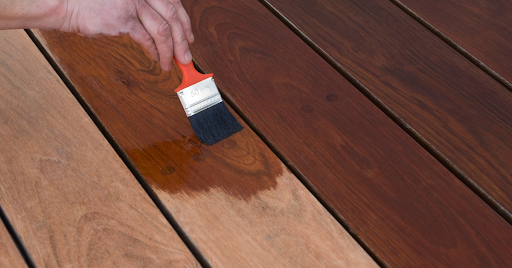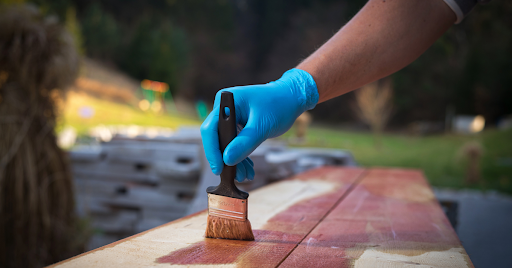Table of Contents
When it comes to staining projects, whether for wood surfaces, furniture, or decks, understanding how long it takes for a stain to dry is crucial for achieving a flawless finish. Knowing the drying time helps ensure that the stain sets properly, allowing for the next steps, whether it’s applying additional coats or protective sealants. The drying time for stains can vary widely depending on the type of stain, the wood type, and the environmental conditions in which you work.
In this guide, we’ll explore drying times for different types of stains, key factors that affect drying, and expert tips for optimal results.
What Is Wood Stain?
Wood stain is a product used to modify the color and appearance of wood surfaces. It enhances the wood’s natural grain and texture, creating a more refined look. It is typically used for both decorative and protective purposes on various wood projects.
Types of Wood Stains and Their Drying Times:
Understanding the different types of stains available can help you pick the right product for your project and understand the drying times for each one.
Here’s a breakdown of common wood stain types:
1. Water-Based Stains:
These fast-drying, low-odor stains are easy to clean with soap and water. While they work well for quick or indoor projects, they may not penetrate wood as deeply as oil-based stains and can raise the wood grain, requiring extra sanding for a smooth finish.
Drying Time: Water-based stains dry relatively quickly, typically within 4 to 6 hours between coats. Full curing can take anywhere from 24 to 72 hours.
2. Oil-Based Stains:
These stains deeply penetrate wood, offering vibrant color and durable, long-lasting protection. They’re ideal for high-traffic and outdoor areas but require longer drying times and have a strong odor, so good ventilation is essential.
Drying Time: Oil-based stains generally require 6 to 12 hours between coats, with full curing taking anywhere from 24 to 48 hours.
3. Gel Stains:
With a thicker consistency, gel stains are easier to control, especially on vertical surfaces or intricate woodwork. They provide an even application but take longer to dry compared to other types. Gel stains may leave behind excess residue that requires wiping off to achieve a smooth finish.
Drying Time: Gel stains typically take 8 to 24 hours to fully dry between coats, with full curing taking up to 72 hours.

how long for wood stain to dry
4. Lacquer Stains:
Lacquer stains are perfect for fast-paced projects and are often used in high-end furniture due to their glossy finish. However, they require good ventilation because of their strong fumes.
Drying Time: Lacquer stains dry incredibly fast typically within 15 minutes to 1 hour depending on thickness. Full curing will usually take 24 hours.
5. Dye Stains:
Dye stains offer vibrant colors that penetrate deep into the wood grain, highlighting its natural texture. Ideal for specialty projects like musical instrument finishes or antique restoration, they dry quickly, requiring fast application to achieve the desired result before they set.
Drying Time: Dye stains, whether water-soluble or alcohol-based, dry quite quickly typically within 15 minutes to 1 hour for each coat, with full curing taking up to 24 hours.
Environmental Factors That Affect Drying Times:
Environmental factors like temperature and humidity significantly influence stain drying times. Adjusting to these conditions ensures a smooth, even finish.
Temperature:
- Ideal Conditions: Staining is best done in temperatures between 70°F and 80°F (21°C to 26°C). In these conditions, stains will dry relatively quickly and evenly.
- Extreme Heat: High temperatures can cause the stain to dry too quickly, resulting in uneven absorption or streaks. If it’s too hot, try to work in a shaded area or during cooler hours of the day.
- Cold: Low temperatures slow down drying, and some stains (especially water-based stains) can freeze, rendering them unusable. In cold weather, it’s important to let stains dry indoors, away from drafts and heating sources that could cause inconsistent drying.
Humidity:
- High Humidity: High humidity slows the evaporation of moisture in the stain, extending the drying time significantly. If you live in a humid climate, using a dehumidifier or working in a ventilated space can help speed up the drying process.
- Low Humidity: Low humidity may cause a stain to dry too quickly, resulting in a blotchy or uneven finish. If you’re working in low-humidity conditions, consider applying thinner layers to avoid streaking or blotchiness.
How to Improve Drying Time:
If you need to speed up the drying time of your wood stain, there are several things you can do:
1. Increase Airflow:
Use fans or work in an open area with plenty of ventilation. This will help the solvent in the stain evaporate faster.
2. Use a Space Heater or Dehumidifier:
If you’re working in a cooler or more humid environment, a space heater or dehumidifier can help to promote faster drying by lowering moisture in the air and raising the temperature to optimal levels.
3. Thin the Stain:
In certain situations, especially with oil-based stains, you can thin the stain with mineral spirits or another appropriate solvent to help it dry faster and spread more evenly.
4. Work in Optimal Conditions:
As mentioned before, aim to work within moderate temperature and humidity levels. If possible, avoid working in extreme weather conditions, as this can significantly affect drying time.

how long for wood stain to dry
Re-coating and Applying a Top Coat:
Before applying a top coat or re-coating, it’s important to allow the stain to fully cure to avoid uneven finishes. The curing times differ by stain type:
- Water-Based Stains: Wait 24-72 hours for full curing before applying a finish.
- Oil-Based Stains: Wait 24-48 hours for the stain to cure fully.
- Gel Stains: Wait 72 hours for full curing before applying a top coat.
- Lacquer Stains: Can typically be recoated 1-2 hours after drying but wait for 24 hours to fully cure.
- Dye Stains: Allow about 24 hours for curing before applying a finish.
How to Test If Your Stain Is Dry
To check if your stain is dry, lightly touch a small, inconspicuous area. If the stain feels dry to the touch and doesn’t leave any sticky residue, it’s likely ready for further coats or to be sealed. If it still feels tacky, give it more time to dry.
For some stains, you may need to wait 24 hours before applying a topcoat or additional layers, especially with oil-based stains that require extended curing times.
Common Mistakes to Avoid
Avoiding common mistakes can help ensure a smooth, even finish when staining wood.
Here are key errors to watch for:
- Applying a Topcoat Too Soon: Applying a topcoat or second layer before the stain has fully dried can result in streaks and an uneven finish. Always ensure the stain is completely dry.
- Ignoring Weather Conditions: Staining in high humidity or very low temperatures can increase drying time. Try to avoid staining on rainy days or in cold conditions.
- Using Thick Coats of Stain: Thick layers of stain will not only take longer to dry but may also result in an uneven finish. Stick to thin, even coats.
Conclusion:
Understanding the drying time of wood stains is the way to perfect your finish. All stains take varying times to dry, depending on type, wood, and environment. Adequate time for drying assures that the stain will cure in a perfect smooth finish.
Be aware of the temperature, humidity, and coat thickness since these can either accelerate or retard the drying process. With proper techniques and enough curing time, you will have the best outcome for your staining project. For more home ideas, visit styleofhomes.com.
